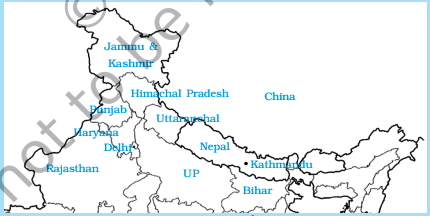NCERT Solutions Class 9, English, Beehive, Prose, Chapter- 8, Kathmandu.
Thinking about the Text
1. On the following map mark out the route, which the author thought of but did not take, to Delhi.

Solution:
The route the author had thought of but did not take is given below:
Kathmandu — Bihar (Patna) — Uttar Pradesh (Benares-Allahabad-Agra) — Delhi
I. Answer these questions in one or two words or in short phrases.
1. Name the two temples the author visited in Kathmandu.
Solution:
The two temples the author visited in Kathmandu were the Pashupatinath temple and the
Baudhnath stupa.
2. The writer says, “All this I wash down with Coca Cola.” What does ‘all this’ refer to?
Solution:
‘All this’ refers to eating a bar of marzipan, a corn-on-the-cob roasted in a charcoal stove (rubbed with salt, chilli powder and lemon), and reading a couple of love story comics and a Reader’s Digest.
3. What does Vikram Seth compare to the quills of a porcupine?
Solution:
Vikram Seth compares the fifty or sixty bansuris protruding in all directions from the pole of a flute seller to the quills of a porcupine.
4. Name five kinds of flutes.
Solution:
The reed neh, the Japanese shakuhachi, the deep bansuri of Hindustani classical music, the clear or breathy flutes of South America, and the high-pitched Chinese flutes.
II. Answer each question in a short paragraph.
1. What difference does the author note between the flute seller and the other hawkers?
Solution:
The author notes that while the other hawkers shouted out their wares, the flute seller did not. He simply played a flute, slowly and meditatively, without excessive display.
2. What is the belief at Pashupatinath about the end of Kaliyug?
Solution:
At Pashupatinath, there is a small shrine that protrudes from the stone platform on the river bank of Bagmati. It is believed that when the shrine will emerge fully, the goddess inside it will escape. The evil period of Kaliyug on earth will then end.
3. The author has drawn powerful images and pictures. Pick out three examples each of
(i) the atmosphere of ‘febrile confusion’ outside the temple of Pashupatinath (for example: some people trying to get the priest’s attention are elbowed aside...)
Solution:
The author has drawn powerful images and pictures of the atmosphere of ‘febrile confusion’ outside the temple of Pashupatinath. These include the following: a group of saffron-clad Westerners struggling to enter the main gate as only Hindus were allowed to enter the temple; a fight that breaks out between two monkeys; and a royal Nepalese princess for whom everyone makes way.
(ii) the things he sees
Solution:
He saw that the Baudhnath Stupa had an immense white dome, which was ringed by a road. Small shops were there on the outer edge where felt bags, Tibetan prints and silver jewellery could be bought. There were no crowds there. On the busiest streets of Kathmandu, he saw fruit sellers, flute sellers, hawkers of postcards, shops selling Western cosmetics, film rolls, chocolate, copper utensils and Nepalese antiques.
(iii) the sounds he hears
Solution:
The sounds he heard were film songs that were blaring out from the radios, car horns, bicycle bells, vendors shouting out their wares. He also listened to flute music, calling it the most universal and most particular of sounds.
III. Answer the following questions in not more than 100–150 words each.
1. Compare and contrast the atmosphere in and around the Baudhnath shrine with the Pashupatinath temple.
Solution:
The atmosphere at the Pashupatinath temple was noisy, and full of chaos and confusion. Worshippers were trying to get the priest’s attention; others were pushing their way to the front; saffron-clad Westerners were trying to enter the temple; monkeys were fighting and adding to the general noise; a corpse was being cremated on the banks of the river Bagmati; washerwomen were at their work, while children were bathing. In contrast, the Baudhnath stupa was “a haven of quietness in the busy streets around”. There was no crowd, which helped build the stillness and serenity at the Buddhist shrine.
2. How does the author describe Kathmandu’s busiest streets?
Solution:
Along Kathmandu’s narrowest and busiest streets, there are small shrines and flower-adorned deities. Apart from these, there are fruit sellers, flute sellers, hawkers of postcards, shops selling Western cosmetics, film rolls, chocolate, those selling copper utensils and Nepalese antiques. The author hears film songs that were blaring out from the radios, sounds of car horns and bicycle bells, vendors shouting out their wares. He says that stray cows roam about on the roads. He also draws a vivid picture of a flute seller with many bansuris protruding from his pole. He describes how the serene music produced by the flute seller is heard clearly above all the other noise.
3. “To hear any flute is to be drawn into the commonality of all mankind.” Why does the author say this?
Solution:
The author considers flute music to be “the most universal and most particular” of all music. This is a musical instrument that is common to all cultures. We have the reed neh, the recorder, the Japanese shakuhachi, the deep bansuri of Hindustani classical music, the clear or breathy flutes of South America, the high-pitched Chinese flutes, etc. Even though each of these has its specific fingering and compass yet, for the author, to hear any flute is “to be drawn into the commonality of all mankind”. This is because in spite of their differences, every flute produces music with the help of the human breath. Similarly, despite the differences in caste, culture, religion, region, all human beings are the same, with the same living breath running through all of them.